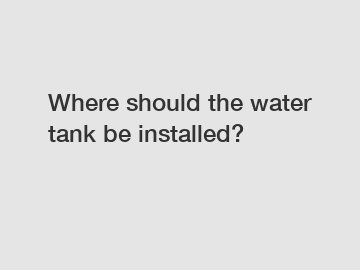Where should the water tank be installed?
Water tanks are an essential part of any residential or commercial property. They provide a reliable source of water for daily use, help in water conservation, and are crucial for emergency situations such as natural disasters or water supply disruptions. However, when it comes to installing a water tank, the question arises: where should it be installed?
There are several factors to consider when deciding on the location for your water tank. Here are some tips to help you make the right choice:
1. Accessibility: One of the most important factors to consider is the accessibility of the water tank. It should be placed in a location that is easily accessible for maintenance and refilling. Ideally, the tank should be installed in a spot that is not too far from the main water source and plumbing connections.

2. Ground stability: The ground where the water tank is installed should be stable and level. Avoid placing the tank on uneven terrain or loose soil, as this can cause the tank to shift or even collapse. A solid concrete foundation can help ensure the stability of the tank.
3. Roof runoff: If you are planning to use the water tank for collecting rainwater, it should be placed in an area where it can easily capture water runoff from the roof. Positioning the tank near a downspout or gutter system can help maximize rainwater collection efficiency.
4. Sun exposure: It is important to consider the sun exposure when choosing a location for your water tank. Direct sunlight can cause the water to heat up, leading to algae growth and bacterial contamination. Placing the tank in a shaded area or using a tank cover can help prevent these issues.
5. Aesthetics: While functionality is key, the aesthetic appeal of the location should also be taken into consideration. Choose a spot that is visually appealing and blends in with the overall landscape of your property. Concealing the tank with landscaping or fencing can help maintain the aesthetic value of your property.
6. Local regulations: Before installing a water tank, be sure to check with local authorities regarding any regulations or permits that may be required. Some areas have specific guidelines for the installation of water tanks, such as setback requirements or size limitations.
7. Future expansion: Consider future expansion when selecting a location for your water tank. If you plan to add more tanks in the future, choose a location that can accommodate additional tanks without overcrowding the space.
In conclusion, the location of your water tank plays a crucial role in its functionality, efficiency, and longevity. By considering factors such as accessibility, ground stability, roof runoff, sun exposure, aesthetics, local regulations, and future expansion, you can make an informed decision on where to install your water tank. Remember to consult with a professional installer for guidance and assistance in selecting the best location for your water tank. With the right placement, your water tank will serve you well for many years to come.
For more information, please visit digester inspection, irrigation water tank, concrete fire tanks.

Comments
0